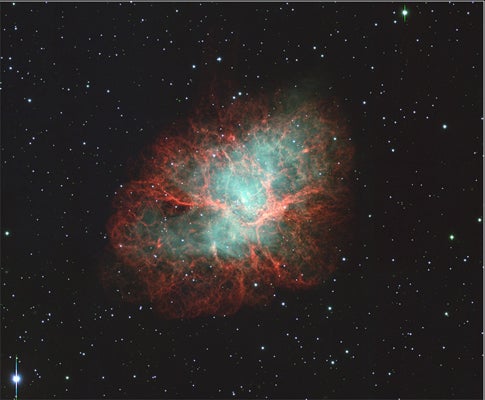A new image of the Crab Nebula supernova remnant taken using the Prime Focus Camera (Suprime-Cam) on the Subaru Telescope highlights the beauty of stellar debris expanding away from the site of this ancient blast. The high-resolution image captures details of an elongated tendril of gas rushing out at roughly 1,500 kilometers per second. While the nebula has been observed many times using both ground- and space-based telescopes, this image is giving astronomers another opportunity to study the mechanics of the expanding gas in much greater detail.
This astonishing image was not taken as part of an ongoing research project, but came about by chance on a night when viewing conditions prevented a team of astronomers from using the telescope for their planned observation. They opted to zero in on the Crab Nebula and take a pretty picture that would also be useful.
“We just wanted to look at something beautiful that could show-off the camera’s ability to take detailed images of a wide field of view,” said Toru Yamada, one of the team members. “As it turns out, my foreign colleagues are interested in the data, which could be useful for research into how the Crab Nebula expands over time.”
The Crab Nebula (M1) supernova remnant is one of the highlights of the winter night sky. It lies about 7,200 light-years away in the constellation Taurus, and has an apparent diameter of 10 light-years. The nebula was created in a tremendous stellar explosion first seen on Earth in the year 1054. Many cultures noted the appearance of this new star in the sky.
In Japan, the noted poet Fujiwara no Teika, wrote in his diary: “Every night, several hours past midnight, an unfamiliar star as bright as Jupiter rises in the eastern sky.” In the American Southwest, many have suspected that several sandstone drawings made by ancient Native Americans of the time, are actually illustrations of the supernova as it appeared in the sky over their homes.
A supernova explosion occurs when a massive star at the end of its life collapses and then explodes outward, emitting intense radiation and stellar debris to space. Such explosions scatter elements like iron, gold, silver, and plutonium out from the shattered star, which enriches surrounding space. The atmosphere of the star creates an expanding nebula, which carries most of the elements along in its wake. What’s left of the star (the remaining core materials) collapses to become a “neutron star” (a dense, hot object made entirely of neutrons). If the neutron star is extremely dense, it could collapse to become a black hole. Astronomers estimate that a supernova explosion takes place once every few decades in a galaxy like the Milky Way.
There are actually two stars at the center of the Crab Nebula, one of which is the neutron star. It rotates rapidly, at a rate of 33 times per second, and emits radio waves, x-rays, and gamma rays out in streams of radiation. We see the x-ray and gamma-ray streams as rapidly changing pulsations in the intensity of the radiation. It’s similar to watching beams from a lighthouse as the light spins around. This pulsing appearance led scientists to call the central star and its beam the Crab Pulsar.










